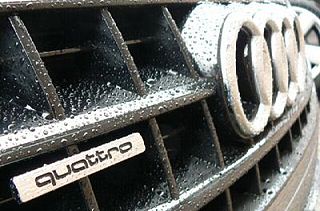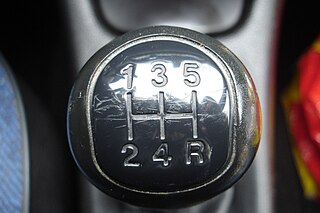
The Volkswagen Golf is a compact car/small family car (C-segment) produced by the German automotive manufacturer Volkswagen since 1974, marketed worldwide across eight generations, in various body configurations and under various nameplates – including as the Volkswagen Rabbit in the United States and Canada, and as the Volkswagen Caribe in Mexico (Mk1).

The Volkswagen Jetta is a compact car/small family car manufactured and marketed by Volkswagen since 1979. Positioned to fill a sedan niche above the firm's Golf hatchback, it has been marketed over seven generations, variously as the Atlantic, Vento, Bora, City Jetta, Jetta City, GLI, Jetta, Clasico, and Sagitar.

Quattro is the trademark used by the automotive brand Audi to indicate that all-wheel drive (AWD) technologies or systems are used on specific models of its automobiles.
A semi-automatic transmission is a multiple-speed transmission where part of its operation is automated, but the driver's input is still required to launch the vehicle from a standstill and to manually change gears. Semi-automatic transmissions were almost exclusively used in motorcycles and are based on conventional manual transmissions or sequential manual transmissions, but use an automatic clutch system. But some semi-automatic transmissions have also been based on standard hydraulic automatic transmissions with torque converters and planetary gearsets.

A direct-shift gearbox is an electronically controlled, dual-clutch, multiple-shaft, automatic gearbox, in either a transaxle or traditional transmission layout, with automated clutch operation, and with fully-automatic or semi-manual gear selection. The first dual-clutch transmissions were derived from Porsche in-house development for the Porsche 962 in the 1980s.
The Ultradrive is an automatic transmission manufactured by Chrysler beginning in the 1989 model year.
The 4F27E is an electronically controlled 4-speed automatic transaxle transmission developed by Mazda and Ford. Mazda's name for this transmission is FN4A-EL, Ford's name for this transmission is 4F27E. Mazda's FS5A-EL is the 5-speed successor to this transmission which shares many of the same parts.

A gear stick, gear lever, gearshift or shifter, more formally known as a transmission lever, is a metal lever attached to the transmission of an automobile. The term gear stick mostly refers to the shift lever of a manual transmission, while in an automatic transmission, a similar lever is known as a gear selector. A gear stick will normally be used to change gear whilst depressing the clutch pedal with the left foot to disengage the engine from the drivetrain and wheels. Automatic transmission vehicles, including hydraulic automatic transmissions, automated manual and older semi-automatic transmissions, like VW Autostick, and those with continuously variable transmissions, do not require a physical clutch pedal.
The name Autostick has been used for a Volkswagen semi-automatic transmission, which is a vacuum-operated automatic clutch system, coupled with a conventional 3-speed manual transmission. The "AutoStick" system designed by Chrysler allows for manual selection of gears with a standard hydraulic automatic transmission, also known as a manumatic.

The Volkswagen Golf Mk5 is a compact car/small family car manufactured and marketed by Volkswagen, as the fifth generation of the Golf in three- or five-door hatchback and a five-door station wagon (2007–2009) configurations, as well as the successor to the Golf Mk4. Using the Volkswagen Group A5 (PQ35) platform, the Mk5 debuted at the Frankfurt Motor Show in October 2003 and went on sale in Europe for the 2004 model year. While marketed as the Volkswagen Rabbit in the United States and Canada, the GTI model in these countries was marketed simply as the Volkswagen GTI.

The Volkswagen Golf Mk4 is a compact car, the fourth generation of the Volkswagen Golf and the successor to the Volkswagen Golf Mk3. Launched in October 1997 for the 1998 model year, it was the best selling car in Europe in 2001.

Digifant is an Engine Management System operated by an Engine Control Unit that actuates outputs, such as fuel injection and ignition systems, using information derived from sensor inputs, such as engine speed, exhaust oxygen and intake air flow. Digifant was designed by Volkswagen Group, in cooperation with Robert Bosch GmbH.

The Volkswagen Golf (Mk7) is a C-segment car manufactured by German automobile manufacturer Volkswagen. It is the seventh generation in the Golf series and the successor to the Golf Mk6. It was introduced in Berlin on 4 September 2012, before a public launch at the 2012 Paris Motor Show. Sales in Europe began with the model in November 2012.

Volkswagen R is the brand used by the German auto manufacturer Volkswagen to indicate a sport or high performance model. An "R" badge is placed on the grille, front fenders and trunk of R-model vehicles to indicate the vehicle's trim level.

The Volkswagen Jetta is a compact car, the fifth generation of the Volkswagen Jetta and the successor to the Volkswagen Bora which was manufactured by Volkswagen between 2005 and 2010, and up to 2012 in China. It is a three-box sedan derivative of the Golf Mk5. It was marketed as the Volkswagen Bora in Mexico and Colombia, Volkswagen Vento in Argentina, Chile and Uruguay, and Volkswagen Sagitar in China.

The Volkswagen Jetta (A6) is a compact car, the sixth generation of the Volkswagen Jetta and the successor to the Jetta (A5). Known as the NCS during its development, it was released in 2010 and was phased out since 2018 to make way for the Jetta (A7). The A6 Jetta is notable for leaving the premium positioning in the compact car segment, a strategy employed by Volkswagen to increase volume in the North American market. It also marked the departure from being a sedan derivative of the Golf, opting for a dedicated bodywork instead.

The Volkswagen Jetta (A7) is a compact car, the seventh generation of the Volkswagen Jetta and the successor to the Volkswagen Jetta (A6). The 2018 Jetta debuted at the 2018 North American International Auto Show in Detroit, Michigan, on 14 January 2018, after Volkswagen released an exterior design sketch in December 2017. The Jetta is based on Volkswagen's MQB platform, which underpins other Volkswagen vehicles including the Volkswagen Golf and the Volkswagen Atlas. The A7 Jetta marked the discontinuation of the nameplate in the European market and right-hand-drive markets.

The Volkswagen Bora is a small family car, the fourth generation of the Volkswagen Jetta, and the successor to the Volkswagen Vento. Production of the car began in July 1999. Carrying on the wind nomenclature from previous generations, the car was known as the Volkswagen Bora in much of the world. Bora is a winter wind that blows intermittently over the coast of the Adriatic Sea, as well as in parts of Greece, Russia, Turkey, and the Sliven region of Bulgaria. In North America and South Africa, the Volkswagen Jetta moniker was again kept on due to the continued popularity of the car in those markets.

The Volkswagen Golf (Mk8) is a compact car, the eighth generation of the Volkswagen Golf and the successor to the Volkswagen Golf Mk7. It was launched in Wolfsburg on 24 October 2019, and arrived in German showrooms in December 2019.












